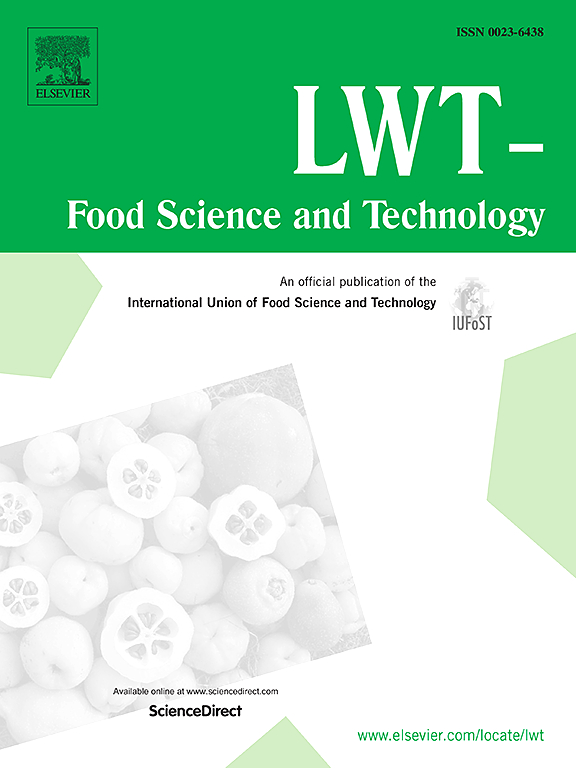Exogenous glycine betaine maintains postharvest blueberry quality by modulating antioxidant capacity and energy metabolism
IF 6
1区 农林科学
Q1 FOOD SCIENCE & TECHNOLOGY
引用次数: 0
Abstract
Blueberries are susceptible to decay and spoilage due to increased respiration rates and metabolism after harvest. The aim of this study was to examine the impact of postharvest application of exogenous glycine betaine (GB) on blueberry storage quality, antioxidant system, and energy metabolism in order to enhance understanding of the regulatory mechanisms of GB on blueberry quality. Fresh blueberries were soaked for 5 min in different concentrations of GB. Preliminary pre-tests revealed that 10 mmol L−1 GB treatment significantly retarded the quality deterioration, decay and dent rate, while increasing the firmness and soluble solid content. Concurrently, exogenous GB treatment resulted in an increase in the content of anthocyanosides, total flavonoids, total phenols, and reduced glutathione, also exhibited higher antioxidant enzyme activities, including superoxide dismutase, catalase, ascorbate peroxidase, polyphenol oxidase, phenylalanine ammonia-lyase, glutathione reductase, dehydroascorbate reductase, and monodehydroascorbate reductase. In GB-treated blueberries, endogenous GB content was significantly higher. The hydrogen peroxide value, superoxide anion, and malondialdehyde content, and higher levels of free radical scavenging rate (DPPH), which significantly improved antioxidant capacity. Meanwhile, succinate dehydrogenase, cytochrome C oxidase, H+-ATPase, and Ca2+-ATPase, decreased and slowed the senescence of blueberries, the ATP content and energy charge were observed to be elevated. In summary, exogenous GB treatment maintained the quality of post-harvest blueberries by increasing their antioxidant capacity and inhibiting the decrease in the activity of energy metabolism-related enzymes. The results indicate that 10 mmol L−1 GB treatment may be an efficacious approach for maintaining the quality and prolonging the shelf life of blueberries, offering novel insights into the preservation of this fruit.
外源性甘氨酸甜菜碱通过调节抗氧化能力和能量代谢保持蓝莓采后品质
蓝莓采收后呼吸速率和新陈代谢加快,容易腐烂和变质。本研究旨在考察采后施用外源甘氨酸甜菜碱(GB)对蓝莓贮藏质量、抗氧化系统和能量代谢的影响,以加深对 GB 对蓝莓质量的调节机制的了解。新鲜蓝莓在不同浓度的 GB 中浸泡 5 分钟。初步预试验表明,10 mmol L-1 GB 处理可显著延缓蓝莓的品质劣变、腐烂和凹陷率,同时提高其坚硬度和可溶性固形物含量。同时,外源 GB 处理可增加花色苷、总黄酮、总酚和还原型谷胱甘肽的含量,并显示出更高的抗氧化酶活性,包括超氧化物歧化酶、过氧化氢酶、抗坏血酸过氧化物酶、多酚氧化酶、苯丙氨酸氨化酶、谷胱甘肽还原酶、脱氢抗坏血酸还原酶和单脱氢抗坏血酸还原酶。在经 GB 处理的蓝莓中,内源性 GB 含量明显较高。过氧化氢值、超氧阴离子和丙二醛的含量以及自由基清除率(DPPH)的水平都有所提高,从而大大提高了抗氧化能力。同时,琥珀酸脱氢酶、细胞色素 C 氧化酶、H+-ATP 酶和 Ca2+-ATP 酶的含量降低,延缓了蓝莓的衰老,观察到 ATP 含量和能量电荷升高。总之,外源 GB 处理可提高蓝莓的抗氧化能力,抑制能量代谢相关酶活性的降低,从而保持采后蓝莓的品质。结果表明,10 mmol L-1 GB 处理可能是保持蓝莓质量和延长其货架期的有效方法,为这种水果的保存提供了新的见解。
本文章由计算机程序翻译,如有差异,请以英文原文为准。
求助全文
约1分钟内获得全文
求助全文
来源期刊

LWT - Food Science and Technology
工程技术-食品科技
CiteScore
11.80
自引率
6.70%
发文量
1724
审稿时长
65 days
期刊介绍:
LWT - Food Science and Technology is an international journal that publishes innovative papers in the fields of food chemistry, biochemistry, microbiology, technology and nutrition. The work described should be innovative either in the approach or in the methods used. The significance of the results either for the science community or for the food industry must also be specified. Contributions written in English are welcomed in the form of review articles, short reviews, research papers, and research notes. Papers featuring animal trials and cell cultures are outside the scope of the journal and will not be considered for publication.
 求助内容:
求助内容: 应助结果提醒方式:
应助结果提醒方式:


